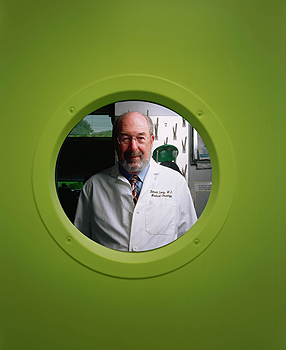SPRING 2009 CONTENTS
Home
The demonization of immunization
Shots get the once-over
What is a vaccine?
Immunization demystified
Asking How
Vaccine Side Effects Probed
When science gets hijacked
NBC News chief medical editor tells why she broke her silence
Insourced to India
A vaccine for a scourge of the developing world
Peet’s passion
The medical education of Amanda Peet
Field yields
Can genetically engineered plants provide vaccines?
Shoot it, donít smoke it
An injectable tobacco-grown vaccine
Golden needles
Vaccines for seniors
Grow up
Can vaccines built for kids work in older immune systems too?


Shoot it,
donít smoke it
An injectable tobacco-grown vaccine
By Erin Digitale
Photograph by Trujillo-Paumier
Plants could act as safe, speedy factories for personalized treatments against a common form of cancer, according to recent findings from Stanford’s School of Medicine. The results came in the first human tests of an injectable treatment grown in tobacco plants — a new type of vaccine that fights disease instead of preventing it.
The treatments, which would vaccinate cancer patients against their malignant cells, could lead to earlier therapy to tackle follicular B-cell lymphoma, an immune-system malignancy diagnosed in about 16,000 people in the United States each year, commonly considered incurable. The standard treatment, chemotherapy, has such severe side effects that patients often opt for watchful waiting in the early stages of illness. However, plant-grown vaccines, which lack side effects, could allow earlier, more aggressive management of the cancer.
“This would be a way to treat cancer without side effects,” says Stanford professor of oncology Ronald Levy, MD, the study’s senior author. “The idea is to marshal the body’s own immune system to fight cancer.”
In a phase-1 trial published last July, Levy’s team showed that plant-grown cancer vaccines were safe for patients and could be produced quickly and cheaply. Sixteen newly diagnosed lymphoma patients received the treatment; none experienced any side effects. Future studies, including a clinical trial being conducted by drug maker Bayer, will test a similar vaccine’s effectiveness.
The cancer vaccines rely on a biological quirk of follicular B-cell lymphoma. The cancer starts when a single immune cell multiplies uncontrollably, producing many identical clones of itself. The clones all carry the same antibody on their exterior, a marker that is not found on any of the body’s healthy cells. Levy’s vaccination strategy is to inject many copies of the cancer-specific antibody into a newly diagnosed lymphoma patient, stimulating the patient’s immune system to seek and destroy malignant cells.
To make a tobacco plant churn out a human antibody, scientists isolate the antibody from the patient’s tumor and put the antibody gene into a modified version of the tobacco mosaic virus. They infect a tobacco plant with the gene-carrying virus by scratching the virus on its leaves. The virus takes the gene into the plant’s cells, which then churn out lots of antibody. After a few days, technicians snip off the plant’s leaves, grind them up and purify the antibody. Only a few plants are needed to make enough vaccine for each patient.
“The new manufacturing system allows very rapid production of a vaccine,” says vaccine researcher Charles Arntzen, PhD, a professor of plant biology at Arizona State University, who was not involved in the research. Growing a personalized vaccine takes a few weeks in a plant system, versus several months in cultured mammalian cells. The plant system is also significantly cheaper than alternate antibody production strategies. A similar bioengineering method is also being investigated by the Delaware-based contract research organization Fraunhofer USA to rapidly manufacture influenza vaccines.
None of the harmful chemicals found in cigarettes end up in the purified vaccines, says Levy. “It’s pretty cool technology. And it’s really ironic that you would make a treatment for cancer out of tobacco.”
Related story:
Field yields
Advocates for bioengineered plants are bumping hard against increasingly cautious regulators and growing public skepticism.

